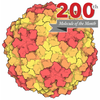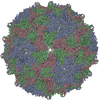+ Open data
Open data
- Basic information
Basic information
| Entry |  | |||||||||
|---|---|---|---|---|---|---|---|---|---|---|
| Title | Early disassembly intermediate of Flock House Virus | |||||||||
 Map data Map data | ||||||||||
 Sample Sample |
| |||||||||
 Keywords Keywords | Disassembly / Flock House Virus / Asymmetric reconstruction / Single Particle Reconstruction / VIRUS | |||||||||
| Function / homology |  Function and homology information Function and homology informationnodavirus endopeptidase / symbiont entry into host cell via permeabilization of host membrane / T=3 icosahedral viral capsid / aspartic-type endopeptidase activity / proteolysis / metal ion binding Similarity search - Function | |||||||||
| Biological species |  Flock house virus / Flock house virus /  Flock House virus Flock House virus | |||||||||
| Method | single particle reconstruction / cryo EM / Resolution: 3.1 Å | |||||||||
 Authors Authors | Lokshman MK / Kumar D / Borkotoky S / Banerjee M | |||||||||
| Funding support |  India, 1 items India, 1 items
| |||||||||
 Citation Citation |  Journal: J Mol Biol / Year: 2025 Journal: J Mol Biol / Year: 2025Title: A Disassembly Intermediate of a Non-enveloped Virus Indicates the Pathway of Genome Release. Authors: Milan Kumar Lokshman / Kirti Suhag / Devbrat Kumar / Subhomoi Borkotoky / Manidipa Banerjee /  Abstract: Disassembly of non-enveloped viruses in vivo are typically triggered by cellular factors such as host receptor binding, low pH in the early or late endosomal compartments, protease action in ...Disassembly of non-enveloped viruses in vivo are typically triggered by cellular factors such as host receptor binding, low pH in the early or late endosomal compartments, protease action in lysosomes, and localized changes in ionic concentrations. These triggers induce alterations in metastable capsids, resulting in the exposure of flexible capsid components and opening of gaps for genome release. Structural analysis of intermediate states is required to understand alterations in protein-protein and RNA-protein contacts in the pathway of capsid destabilization. Obtaining structural details of intermediates requires recreation of the in vivo transition states in stable forms, stepwise, in vitro. Here, we generated an asymmetric reconstruction of an early intermediate state in the disassembly pathway of Flock House Virus, a T = 3 icosahedral insect virus that is a model system for similar-sized non-enveloped viruses. The early intermediate was generated through judicious application, in vitro, of in vivo conditions such as receptor-binding-related transition and endosomal pH. The early intermediate showed asymmetric expansion, as well as asymmetric dynamic movement of the pocket factor, disordering of flexible membrane penetrating peptides and opening of gaps at the 2-fold axis, indicating that disassembly-related structural alterations may be local and not transpire throughout the icosahedral capsid. Surprisingly, the genomic RNA underwent a dramatic conformational alteration which superseded the relatively more subtle changes in the protein component. Recreation of disassembly-related transition states in vitro may be essential for structure-targeted, broadly effective inactivation strategies for non-enveloped viruses. | |||||||||
| History |
|
- Structure visualization
Structure visualization
| Supplemental images |
|---|
- Downloads & links
Downloads & links
-EMDB archive
| Map data |  emd_63529.map.gz emd_63529.map.gz | 398.9 MB |  EMDB map data format EMDB map data format | |
|---|---|---|---|---|
| Header (meta data) |  emd-63529-v30.xml emd-63529-v30.xml emd-63529.xml emd-63529.xml | 19.1 KB 19.1 KB | Display Display |  EMDB header EMDB header |
| FSC (resolution estimation) |  emd_63529_fsc.xml emd_63529_fsc.xml | 15.8 KB | Display |  FSC data file FSC data file |
| Images |  emd_63529.png emd_63529.png | 273.4 KB | ||
| Masks |  emd_63529_msk_1.map emd_63529_msk_1.map | 421.9 MB |  Mask map Mask map | |
| Filedesc metadata |  emd-63529.cif.gz emd-63529.cif.gz | 6.1 KB | ||
| Others |  emd_63529_half_map_1.map.gz emd_63529_half_map_1.map.gz emd_63529_half_map_2.map.gz emd_63529_half_map_2.map.gz | 391.7 MB 391.7 MB | ||
| Archive directory |  http://ftp.pdbj.org/pub/emdb/structures/EMD-63529 http://ftp.pdbj.org/pub/emdb/structures/EMD-63529 ftp://ftp.pdbj.org/pub/emdb/structures/EMD-63529 ftp://ftp.pdbj.org/pub/emdb/structures/EMD-63529 | HTTPS FTP |
-Validation report
| Summary document |  emd_63529_validation.pdf.gz emd_63529_validation.pdf.gz | 1.4 MB | Display |  EMDB validaton report EMDB validaton report |
|---|---|---|---|---|
| Full document |  emd_63529_full_validation.pdf.gz emd_63529_full_validation.pdf.gz | 1.4 MB | Display | |
| Data in XML |  emd_63529_validation.xml.gz emd_63529_validation.xml.gz | 25.3 KB | Display | |
| Data in CIF |  emd_63529_validation.cif.gz emd_63529_validation.cif.gz | 33.2 KB | Display | |
| Arichive directory |  https://ftp.pdbj.org/pub/emdb/validation_reports/EMD-63529 https://ftp.pdbj.org/pub/emdb/validation_reports/EMD-63529 ftp://ftp.pdbj.org/pub/emdb/validation_reports/EMD-63529 ftp://ftp.pdbj.org/pub/emdb/validation_reports/EMD-63529 | HTTPS FTP |
-Related structure data
| Related structure data |  9lzlMC  9lzwMC M: atomic model generated by this map C: citing same article ( |
|---|---|
| Similar structure data | Similarity search - Function & homology  F&H Search F&H Search |
- Links
Links
| EMDB pages |  EMDB (EBI/PDBe) / EMDB (EBI/PDBe) /  EMDataResource EMDataResource |
|---|---|
| Related items in Molecule of the Month |
- Map
Map
| File |  Download / File: emd_63529.map.gz / Format: CCP4 / Size: 421.9 MB / Type: IMAGE STORED AS FLOATING POINT NUMBER (4 BYTES) Download / File: emd_63529.map.gz / Format: CCP4 / Size: 421.9 MB / Type: IMAGE STORED AS FLOATING POINT NUMBER (4 BYTES) | ||||||||||||||||||||||||||||||||||||
|---|---|---|---|---|---|---|---|---|---|---|---|---|---|---|---|---|---|---|---|---|---|---|---|---|---|---|---|---|---|---|---|---|---|---|---|---|---|
| Projections & slices | Image control
Images are generated by Spider. | ||||||||||||||||||||||||||||||||||||
| Voxel size | X=Y=Z: 1.1 Å | ||||||||||||||||||||||||||||||||||||
| Density |
| ||||||||||||||||||||||||||||||||||||
| Symmetry | Space group: 1 | ||||||||||||||||||||||||||||||||||||
| Details | EMDB XML:
|
-Supplemental data
-Mask #1
| File |  emd_63529_msk_1.map emd_63529_msk_1.map | ||||||||||||
|---|---|---|---|---|---|---|---|---|---|---|---|---|---|
| Projections & Slices |
| ||||||||||||
| Density Histograms |
-Half map: #2
| File | emd_63529_half_map_1.map | ||||||||||||
|---|---|---|---|---|---|---|---|---|---|---|---|---|---|
| Projections & Slices |
| ||||||||||||
| Density Histograms |
-Half map: #1
| File | emd_63529_half_map_2.map | ||||||||||||
|---|---|---|---|---|---|---|---|---|---|---|---|---|---|
| Projections & Slices |
| ||||||||||||
| Density Histograms |
- Sample components
Sample components
-Entire : Flock House virus
| Entire | Name:  Flock House virus Flock House virus |
|---|---|
| Components |
|
-Supramolecule #1: Flock House virus
| Supramolecule | Name: Flock House virus / type: virus / ID: 1 / Parent: 0 / Macromolecule list: all / NCBI-ID: 12287 / Sci species name: Flock House virus / Virus type: VIROID / Virus isolate: OTHER / Virus enveloped: No / Virus empty: No |
|---|
-Macromolecule #1: Capsid protein alpha
| Macromolecule | Name: Capsid protein alpha / type: protein_or_peptide / ID: 1 / Number of copies: 6 / Enantiomer: LEVO / EC number: nodavirus endopeptidase |
|---|---|
| Source (natural) | Organism:  Flock house virus Flock house virus |
| Molecular weight | Theoretical: 39.367355 KDa |
| Recombinant expression | Organism:  |
| Sequence | String: MVNNNRPRRQ RAQRVVVTTT QTAPVPQQNV PRNGRRRRNR TRRNRRRVRG MNMAALTRLS QPGLAFLKCA FAPPDFNTDP GKGIPDRFE GKVVSRKDVL NQSISFTAGQ DTFILIAPTP GVAYWSASVP AGTFPTSATT FNPVNYPGFT SMFGTTSTSR S DQVSSFRY ...String: MVNNNRPRRQ RAQRVVVTTT QTAPVPQQNV PRNGRRRRNR TRRNRRRVRG MNMAALTRLS QPGLAFLKCA FAPPDFNTDP GKGIPDRFE GKVVSRKDVL NQSISFTAGQ DTFILIAPTP GVAYWSASVP AGTFPTSATT FNPVNYPGFT SMFGTTSTSR S DQVSSFRY ASMNVGIYPT SNLMQFAGSI TVWKCPVKLS TVQFPVATDP ATSSLVHTLV GLDGVLAVGP DNFSESFIKG VF SQSACNE PDFEFNDILE GIQTLPPANV SLGSTGQPFT MDSGAEATSG VVGWGNMDTI VIRVSAPEGA VNSAILKAWS CIE YRPNPN AMLYQFGHDS PPLDEVALQE YRTVARSLPV AVIAAQN UniProtKB: Capsid protein alpha |
-Macromolecule #2: Capsid protein alpha
| Macromolecule | Name: Capsid protein alpha / type: protein_or_peptide / ID: 2 / Number of copies: 6 / Enantiomer: LEVO / EC number: nodavirus endopeptidase |
|---|---|
| Source (natural) | Organism:  Flock house virus Flock house virus |
| Molecular weight | Theoretical: 4.399056 KDa |
| Recombinant expression | Organism:  |
| Sequence | String: ASMWERVKSI IKSSLAAASN IPGPIGVAAS GISGLSALFE GFGF UniProtKB: Capsid protein alpha |
-Experimental details
-Structure determination
| Method | cryo EM |
|---|---|
 Processing Processing | single particle reconstruction |
| Aggregation state | particle |
- Sample preparation
Sample preparation
| Concentration | 1 mg/mL |
|---|---|
| Buffer | pH: 5.5 |
| Grid | Model: Quantifoil R2/2 / Material: COPPER / Mesh: 300 / Pretreatment - Type: GLOW DISCHARGE / Pretreatment - Time: 60 sec. |
| Vitrification | Cryogen name: ETHANE / Chamber humidity: 100 % / Chamber temperature: 293 K / Instrument: FEI VITROBOT MARK IV |
| Details | Purified wild type FHV particles were treated with low pH and incrementally heated up to 46 degree celcius. |
- Electron microscopy
Electron microscopy
| Microscope | TFS KRIOS |
|---|---|
| Image recording | Film or detector model: GATAN K3 BIOQUANTUM (6k x 4k) / Average electron dose: 39.7 e/Å2 |
| Electron beam | Acceleration voltage: 300 kV / Electron source:  FIELD EMISSION GUN FIELD EMISSION GUN |
| Electron optics | Illumination mode: FLOOD BEAM / Imaging mode: BRIGHT FIELD / Cs: 2.7 mm / Nominal defocus max: 2.5 µm / Nominal defocus min: 0.25 µm / Nominal magnification: 81000 |
| Sample stage | Specimen holder model: FEI TITAN KRIOS AUTOGRID HOLDER / Cooling holder cryogen: NITROGEN |
| Experimental equipment |  Model: Titan Krios / Image courtesy: FEI Company |
 Movie
Movie Controller
Controller





 Z (Sec.)
Z (Sec.) Y (Row.)
Y (Row.) X (Col.)
X (Col.)














































